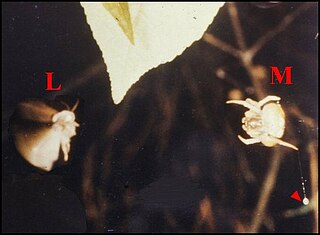
The Pholcidae are a family of araneomorph spiders. The family contains over 1,800 individual species of pholcids, including those commonly known as cellar spider, daddy long-legs spider, carpenter spider, daddy long-legger, vibrating spider, gyrating spider, long daddy, and skull spider. The family, first described by Carl Ludwig Koch in 1850, is divided into 94 genera.

Compsodecta is a genus of Caribbean jumping spiders that was first described by Eugène Louis Simon in 1903.

Stanwellia grisea is a species of false tarantula in the spider family Nemesiidae. It is found in Australia (Victoria).

Hamadruas is a genus of Asian lynx spiders that was first described by Christa Laetitia Deeleman-Reinhold in 2009.
Encoptarthria is a genus of Australian ground spiders that was first described by Barbara York Main in 1954. Originally placed in the no longer recognized family Prodidomidae, it was moved to the family Gnaphosidae in 2007.
Hamataliwa helia is a species of lynx spider in the family Oxyopidae. It is found in the United States, Mexico, Guyana, Thailand, Malaysia (Sarawak), Brunei, and Indonesia (Sumatra).
Enoplognatha marmorata, the marbled cobweb spider, is a species of cobweb spider in the family Theridiidae. It is found in North America.

Habronattus signatus is a species of jumping spider in the family Salticidae. It is found in the United States and Mexico.

Mastophora cornigera is a species of orb weaver in the spider family Araneidae. It is found in a range from the United States to Nicaragua. Like all known species of the genus Mastophora, adult females are bolas spiders, capturing their prey with one or more sticky drops at the end of a single line of silk rather than in a web. Males and juvenile females capture their prey directly with their legs.

Peucetia longipalpis is a species of lynx spider in the family Oxyopidae. It is found in a range from the United States to Venezuela.It was first described by Frederick Octavius Picard-Cambridge in the year 1902.
Clubiona riparia, the riparian sac spider, is a species of sac spider in the family Clubionidae. It is found in Russia, Mongolia, China, Japan, and North America.

Thanatus vulgaris is a species of running crab spider in the family Philodromidae. It is found in North America, Europe, North Africa, Turkey, Israel, Caucasus, a range from Russia, Central Asia, China, and Korea.
Socalchemmis idyllwild is a species of false wolf spiders & wandering spiders in the family Zoropsidae. It is found in the United States.
Barilepis grisea is a species of flower weevil in the beetle family Curculionidae. It is found in North America.
Barilepis is a genus of flower weevils in the beetle family Curculionidae. There are at least four described species in Barilepis.

Castianeira crocata is a species of true spider in the family Corinnidae, sometimes called by the common name red stripe spider. It is found in the United States. Though its body shape is quite different, its characteristic black body and red-marked back puts it at risk of being mistaken for a black widow spider.

Soronia grisea is a species of sap-feeding beetle in the family Nitidulidae. It is found in Europe and Northern Asia, North America, and Southern Asia.

Soronia is a genus of sap-feeding beetles in the family Nitidulidae. There are about 14 described species in Soronia.
Banasa grisea is a species of stink bug in the family Pentatomidae. It is found in North America.
Holothuria grisea, the gray sea cucumber, is a mid-sized coastal species of sea cucumber found in shallow tropical waters of the Atlantic Ocean from Florida to Southern Brazil and West Africa. They have a variety in color and can range from red to more yellowish with brown markings. They are also a food source for local and international markets with the majority of harvesting taking place in Brazil. This species is currently not over-fished and is not endangered or threatened.











